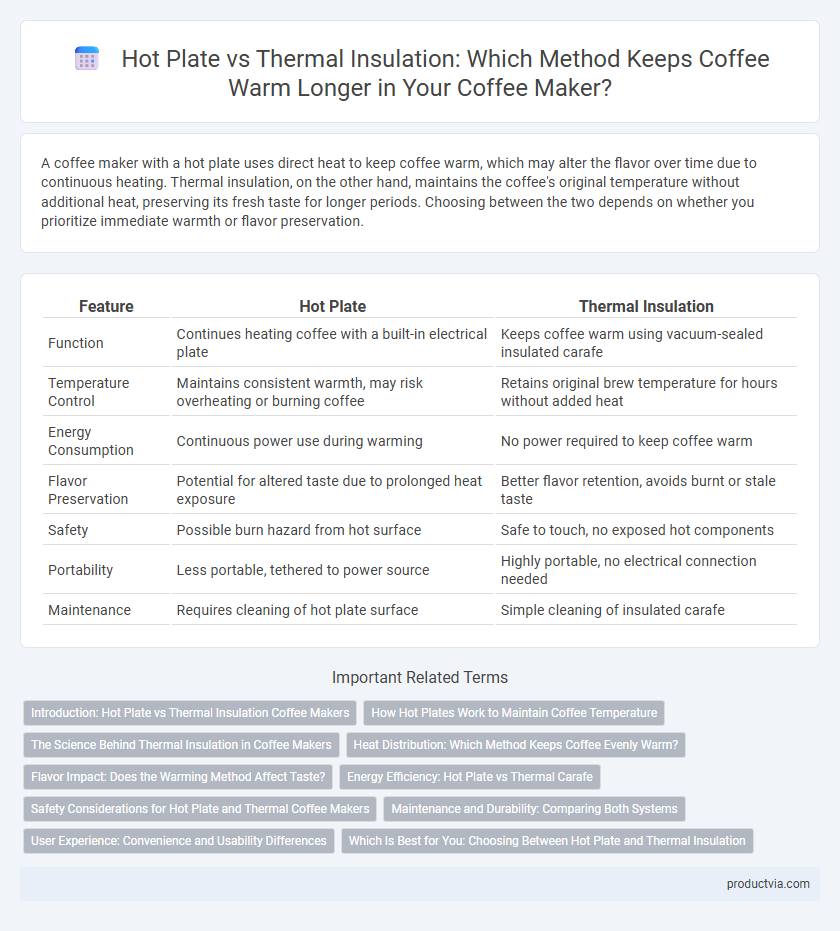A coffee maker with a hot plate uses direct heat to keep coffee warm, which may alter the flavor over time due to continuous heating. Thermal insulation, on the other hand, maintains the coffee's original temperature without additional heat, preserving its fresh taste for longer periods. Choosing between the two depends on whether you prioritize immediate warmth or flavor preservation.
Table of Comparison
| Feature | Hot Plate | Thermal Insulation |
|---|---|---|
| Function | Continues heating coffee with a built-in electrical plate | Keeps coffee warm using vacuum-sealed insulated carafe |
| Temperature Control | Maintains consistent warmth, may risk overheating or burning coffee | Retains original brew temperature for hours without added heat |
| Energy Consumption | Continuous power use during warming | No power required to keep coffee warm |
| Flavor Preservation | Potential for altered taste due to prolonged heat exposure | Better flavor retention, avoids burnt or stale taste |
| Safety | Possible burn hazard from hot surface | Safe to touch, no exposed hot components |
| Portability | Less portable, tethered to power source | Highly portable, no electrical connection needed |
| Maintenance | Requires cleaning of hot plate surface | Simple cleaning of insulated carafe |
Introduction: Hot Plate vs Thermal Insulation Coffee Makers
Hot plate coffee makers maintain coffee warmth by continuously heating the pot, ensuring immediate availability but risking burnt or bitter flavors over time. Thermal insulation coffee makers use vacuum-sealed carafes or insulated materials to preserve heat without additional energy, maintaining optimal flavor and temperature longer. Choosing between these methods depends on user preference for taste preservation versus instant heat availability.
How Hot Plates Work to Maintain Coffee Temperature
Hot plates maintain coffee temperature by using a low-level electric heating element that continuously warms the coffee pot's base, preventing rapid cooling. Thermal insulation, in contrast, relies on vacuum-sealed or double-walled containers to retain heat passively without additional energy. While hot plates actively supply heat, they may risk overheating coffee, affecting taste, whereas thermal insulation preserves temperature more evenly over time.
The Science Behind Thermal Insulation in Coffee Makers
Thermal insulation in coffee makers relies on vacuum-sealed or double-walled carafes to minimize heat transfer through conduction, convection, and radiation, effectively maintaining coffee temperature without continuous energy use. Unlike hot plates that keep coffee warm by applying direct heat, insulating materials such as stainless steel and borosilicate glass preserve flavor and prevent overheating by reducing thermal degradation. Scientific principles of thermodynamics and material science guide the design of insulated carafes to optimize heat retention and extend freshness.
Heat Distribution: Which Method Keeps Coffee Evenly Warm?
Hot plates provide consistent heat but often cause uneven temperature zones, which can lead to coffee tasting burnt or overly hot near the base. Thermal insulation, utilizing vacuum-sealed carafes, maintains coffee temperature evenly by trapping heat without continuous heating, preserving the original flavor and aroma longer. Research shows thermal insulation achieves more uniform heat distribution and better long-term temperature stability compared to hot plates.
Flavor Impact: Does the Warming Method Affect Taste?
Hot plates maintain coffee temperature by continuous heating, which can cause a burnt or bitter taste due to prolonged exposure to heat. Thermal insulation preserves coffee warmth by trapping heat without additional energy, helping retain the original flavor and aroma for longer periods. Choosing thermal insulation over a hot plate results in a fresher, more balanced coffee experience without the negative effects of overheating.
Energy Efficiency: Hot Plate vs Thermal Carafe
Hot plates continuously consume electricity to maintain coffee temperature, leading to higher energy usage over time, while thermal carafes rely on insulated materials to preserve heat without power. Thermal carafes offer superior energy efficiency by minimizing heat loss through vacuum insulation, maintaining coffee warmth for hours without additional energy input. Choosing a thermal carafe reduces electricity costs and environmental impact compared to the constant power draw of hot plate coffee makers.
Safety Considerations for Hot Plate and Thermal Coffee Makers
Hot plates in coffee makers maintain coffee warmth by continuously applying heat, which can pose burn risks and increase fire hazards if left unattended. Thermal insulation preserves coffee temperature without ongoing heat, significantly reducing safety concerns related to overheating or accidental burns. Choosing thermal coffee makers enhances safety by limiting exposure to hot surfaces and minimizing energy consumption while keeping coffee warm effectively.
Maintenance and Durability: Comparing Both Systems
Hot plates require regular cleaning to prevent burnt coffee residue buildup, which can degrade performance and affect taste over time. Thermal insulation systems involve minimal maintenance since they rely on vacuum-sealed carafes that retain heat without continuous energy input, reducing wear and tear. Durability favors thermal insulation as hot plates exposed to constant heat may crack or malfunction, while insulated carafes typically maintain their integrity longer with proper care.
User Experience: Convenience and Usability Differences
Hot plates maintain coffee temperature through continuous heat, ensuring immediate warmth but risking burnt flavors and requiring frequent monitoring. Thermal insulation preserves coffee warmth without additional heat, enhancing flavor retention and reducing energy use, yet may cool gradually over time. Users seeking quick access and strong warmth favor hot plates, while those prioritizing taste and low maintenance prefer thermal insulation.
Which Is Best for You: Choosing Between Hot Plate and Thermal Insulation
A hot plate keeps coffee warm by continuously heating the pot, ideal for those who prefer a readily available, piping-hot brew but may risk a slightly burnt taste over time. Thermal insulation preserves heat by trapping it within an insulated carafe, offering longer-lasting warmth without altering the coffee's flavor, perfect for users prioritizing taste and energy efficiency. Selecting between hot plate and thermal insulation depends on your preference for immediate heat maintenance versus preserving the coffee's original flavor over extended periods.
Hot plate vs Thermal insulation for keeping coffee warm Infographic

 productvia.com
productvia.com